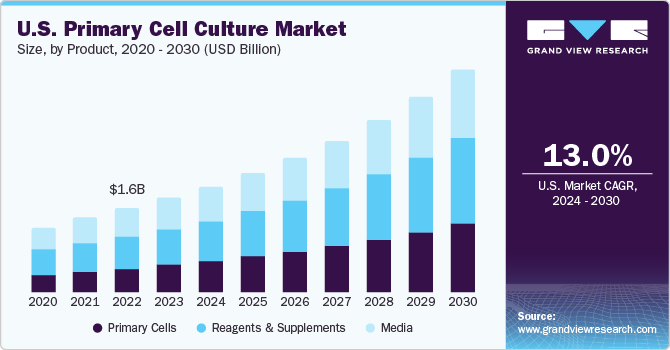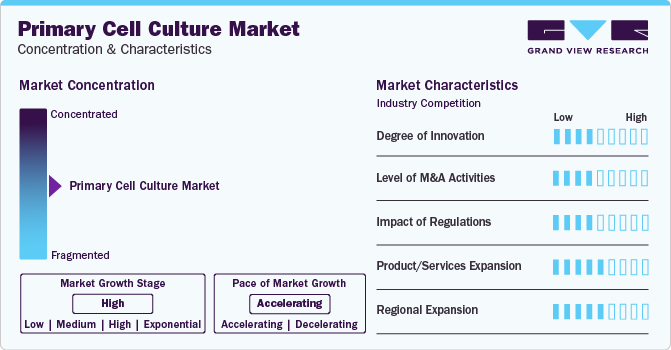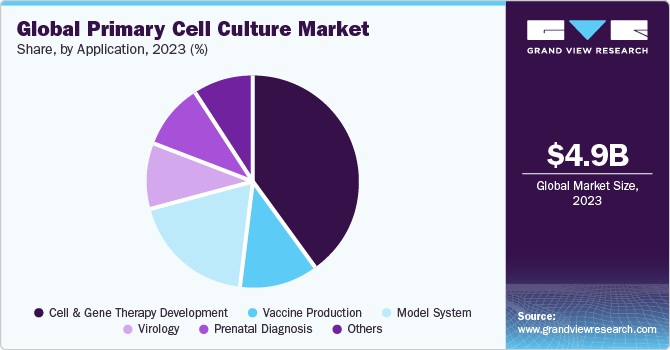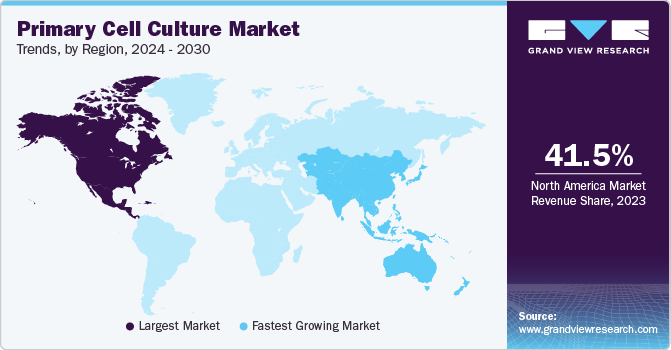- Home
- »
- Biotechnology
- »
-
Primary Cell Culture Market Size, Industry Report, 2030GVR Report cover
![Primary Cell Culture Market Size, Share & Trends Report]()
Primary Cell Culture Market Size, Share & Trends Analysis Report By Product (Logistics & Distribution, Storage & Retention), By Separation Method, By Cell Type, By Application, By Region, And Segment Forecasts, 2024 - 2030
- Report ID: GVR-2-68038-590-8
- Number of Report Pages: 125
- Format: PDF, Horizon Databook
- Historical Range: 2018 - 2022
- Forecast Period: 2024 - 2030
- Industry: Healthcare
Primary Cell Culture Market Size & Trends
The global primary cell culture market size was estimated at USD 4.87 billion in 2023 and is projected to grow at a CAGR of 13.3% from 2024 to 2030. The market growth can be primarily attributed to the increasing prevalence of chronic conditions, such as cancer, infections, autoimmune diseases, diabetes mellitus, cardiovascular diseases, and neprological diseases. This has led to an increase in research, facilitating the high adoption of primary cell cultures.

Furthermore, the growing need for primary cell culture is being driven by increased research to find novel treatments. Cancer is becoming increasingly prevalent all across the world. According to WHO projections, the number of cancer deaths worldwide will continue to climb and will reach over 17 billion by 2030. Moreover, as per American Cancer Society (ACS) Journals published in February 2021, there are 19.3 million cancer cases worldwide, and 10.0 million new cancer cases were recorded in 2020. A rapid growth in incidence of cancer across the globe will lead to an increased demand for novel therapeutics, hence anticipated to propel market growth.
The increasing use of primary cell cultures for in-vitro testing and drug screening has also contributed to the market’s rise. These are derived from tissues, allowing researchers to analyze cellular structure in vivo while demonstrating normal functioning. As a result, they are employed as model systems to investigate cell biochemistry and physiology, aging processes, signaling investigations, metabolic processes, and the effects of harmful substances and medications.
The COVID-19 pandemic is serving as a positive driver for the expansion of the primary cell culture market. Researchers are increasingly turning to primary cell culture to gain insights into the infection. Utilizing standardized and characterized epithelium cell culture models is aiding in comprehending the physical barriers compromised by the coronavirus. These models play a crucial role in mimicking the functions and properties of the respiratory tract, potentially resulting in breakthroughs where research outcomes can translate into valuable medical applications.
Market Concentration & Characteristics
The market experienced notable innovations, including advancements in culture media formulations, 3D cell culture techniques, and the incorporation of cutting-edge technologies, such as bioreactors and microfluidic systems, enhancing the relevance and reliability of in vitro models for research and therapeutic development.

Several market players, such as Thermo Fisher Scientific, Inc., Merck, and Danaher, are involved in merger and acquisition activities. Through M&A activity, these companies can expand their geographic reach and enter new territories.
Compliance with regulations, such as Good Manufacturing Practice (GMP) and ethical standards for sourcing cells, ensures the primary cell cultures’ quality, reproducibility, and ethical use in research and therapeutic development, shaping industry practices and product development strategies.
Potential substitutes in the market include advanced organoid and tissue engineering technologies, and the growing use of stem cell-derived models.
Companies are pursuing regional expansion by establishing local manufacturing facilities and collaborations, aligning with specific regions’ demand variations and regulatory landscape.
Product Insights
The reagents and supplements segment held the largest share of 37.7% in 2023 due to factors such as increasing its routine application in research and manufacturing involving primary cell culture. Since primary cells are fragile in nature, reagents and supplements are considered very crucial for their growth. Furthermore, reagents such as cell culture media, sera, and buffers create an environment that mimics the physiological conditions required for primary cells to survive and proliferate. The availability of various high-quality reagents and supplements tailored for specific cell types and research applications has contributed to their dominance in the primary cell culture market, as researchers rely on these products to ensure successful and reproducible experiments and outcomes.
The primary cells segment is expected to grow significantly during the forecast period. The growth of the primary cells segment can be attributed to their inherent physiological relevance and functional characteristics. Primary cells are isolated directly from tissues or organs, preserving their original biological properties and maintaining the complex interactions within their native microenvironment. Furthermore, companies are investing a lot in improving the development of primary cells to manufacture novel therapies. Further, companies are collaborating with global companies to strengthen their product portfolios. For instance, in April 2023, AnaBios acquired Cell Systems to expand its human cell portfolio for drug development.
Separation Method Insights
The enzymatic degradation segment accounted for the largest revenue share in 2023. The segment’s growth is attributed to its preference over alternative procedures for primary cell separation due to benefits such as reduced damage to cultures and comparatively quick and high yield of a representative sample. Moreover, enzymatic degradation is the most widely used technique for cell disaggregation. This technique provides a high yield of primary cells and employs different enzymes to disaggregate the tissue. Crude trypsin is the enzyme that is mainly used in this technique. Therefore, due to less damaging effect on the cells and more yield, enzymatic disaggregation is the preferred method in primary cell culture separation and culture techniques. For instance, in July 2021, Shizuoka University and NINS conducted research with the help of the enzymatic degradation technique, which helped them significantly improve thermal stability.
The mechanical separation segment is estimated to register the fastest CAGR over the forecast period owing to the advancements in the mechanical separation process. For instance, in October 2020, researchers in France cultured primary skin cells from systemic sclerosis patients using mechanical extraction combined with immuno-magnetic cell sorting. The study concluded that the technique allowed a purity rate of around 80% for human dermal microvascular endothelial cells compared to conventional methods. Moreover, this technique employs careful and skillful chopping, slicing, sieving (forcing the tissues through a series of sieves with reduced mesh size), syringing (forcing the tissue pieces through the syringe), and pipetting of tissues. In addition, the technique also helped overcome the contamination of fibroblasts, which is considered a major issue in obtaining endothelial cells.
Cell Type Insights
The animal cells segment dominated the market in 2023. The growing applications of animal-origin primary cells for vaccine development are major factors fueling the segment’s growth. Animal cells, such as mice, rats, and porcine cells, have been extensively studied and characterized, making them valuable tools for various research applications. They serve as important models for studying human biology, disease mechanisms, drug development, and toxicity testing. Moreover, the segment growth can be attributed to comprehensive product offerings of animal-origin primary cells by companies such as Lonza, Merck KGaA, and Thermo Fisher Scientific, Inc.
The human cells segment has been anticipated to grow significantly over the forecast period. Human cells offer a unique opportunity to study and understand human-specific physiological and pathological processes. They allow researchers to investigate disease mechanisms, evaluate drug efficacy and toxicity, and develop personalized treatment approaches. In 2021, human cells played a crucial role in COVID-19 research, enabling scientists to study the virus's interaction with human cells and develop targeted therapies and vaccines.
Application Insights
The cell & gene therapy development segment dominated the market in 2023. Cell and gene therapy development is dominating the application type segment in the primary cell culture market due to the rapidly growing field of regenerative medicine and the increasing demand for personalized therapies. Cell and gene therapies hold great potential for treating various diseases, including cancer, genetic disorders, and autoimmune conditions. They involve the manipulation and modification of cells or genes to restore or enhance their function, and primary cell culture plays a critical role in their development. As per the IN VIVO CITELINE COMMERCIAL report published in January 2023, 13 new gene therapies could be approved in the U.S. and in Europe by the end of this year. This demonstrates the market's massive need for gene treatments.

The model system segment has been anticipated to show lucrative growth over the forecast period.Model systems dominate the application type segment in the primary cell culture market due to their essential role in understanding biological processes, disease mechanisms, and drug development. Model systems, such as organoids, 3D cell cultures, and tissue engineering constructs, offer a more representative and physiologically relevant environment than traditional 2D cell cultures. Furthermore, companies are investing in adopting more 3D cell culture techniques to enhance their biological research. For instance, in May 2021, CELLINK acquired Visikol, a contract research company that offers high-quality products in 3D tissue imaging, multiplex imaging, and 3D cell culture technique.
Regional Insights
North America dominated the market with a share of 41.5% in 2023. North America is dominating the primary cell culture market due to several factors, including robust research infrastructure, significant investments in biomedical research, and the presence of key industry players. The region has a robust scientific community and well-established research institutions that actively contribute to advancements in cell culture technologies. Additionally, North America is home to numerous biotechnology and pharmaceutical companies investing heavily in primary cell culture research and development.

The U.S. accounted for the largest market share in the North American region in 2023. The U.S. is the hub for operation of major players in supply and logistics market such as Thermo Fisher Scientific, Inc., Merck, and Danaher. Moreover, it has a strong infrastructure, availability of necessary funds, and the ability to adapt to advanced technology drives the overall market growth.
The Asia Pacific region is expected to grow at the fastest CAGR during the forecast period.The growth is primarily due to region’s lower costs associated with stem cell transplantation, thereby contributing to the high demands. In addition, researchers are conducting extensive R&D activities, which can be further attributed to the region’s growth. Additionally, there has been a surge in the development and manufacturing of cell and gene therapies in Asia Pacific, with notable advancements in regenerative medicine, stem cell research, and tissue engineering applications. The growing investment, research capabilities, and cost advantages have propelled the primary cell culture market in the Asia Pacific.
China accounted for the largest market share in the Asia Pacific region in 2023. The country has witnessed substantial growth in its biopharmaceutical and life sciences sectors, driven by significant investments in research and development. China's large population provides a vast pool of diverse cell sources, facilitating extensive primary cell culture research and thereby contributing to the overall market growth in China.
Key Primary Cell Culture Company Insights
Some of the key players operating in the market include Thermo Fisher Scientific, Inc., Merck, and Danaher.
-
Thermo Fisher Scientific, Inc. provides an extensive array of primary cell culture products, encompassing diverse primary cultures, established cell lines, and a comprehensive selection of reagents, media, sera, and growth factors essential for conducting cell culture experiments.
-
Merck delivers a comprehensive solution tailored for the selective cultivation of malignant cells. Additionally, the company offers a portfolio comprising fully characterized, ready-to-use Peripheral Blood Mononuclear Cells (PBMCs) in both standard and disease states, along with a diverse range of immune cell subsets.
-
ATCC and Mattek are some of the emerging market players.
-
ATCC offers a range of primary cell culture products, including cell types such as fibroblasts, endothelial cells, epithelial cells, and various stem cell types.
Key Primary Cell Culture Companies:
The following are the leading companies in the primary cell culture market. These companies collectively hold the largest market share and dictate industry trends. Financials, strategy maps & products of these primary cell culture companies are analyzed to map the supply network.
- Thermo Fisher Scientific, Inc.
- Lonza
- Merck
- Corning Incorporated
- Danaher
- PromoCell GmbH
- ATCC
- FUJIFILM Irvine Scientific, Inc.
- Mattek
- Axol Bioscience Ltd.
Recent Developments
-
In February 2023, Thermo Fisher Scientific, Inc. announced a collaboration with Celltrio, a manufacturing company, to enable a fully automated cell culture system for their customers.
-
In October 2023, Kuraray Co., Ltd. introduced PVA hydrogel microcarriers tailored for cell cultures in regenerative medicine. The product is set to be launched in Japan and globally, with the initial release slated for January 2024, starting in the U.S.
-
In February 2022, CellulaREvolution secured USD 2.2 million in funding to speed up the launch of their Continuous Cell Culture Technology[
Primary Cell Culture Market Report Scope
Report Attribute
Details
Market size value in 2024
USD 5.47 billion
Revenue forecast in 2030
USD 11.59 billion
Growth Rate
CAGR of 13.3% from 2024 to 2030
Base year for estimation
2023
Historical data
2018 - 2022
Forecast period
2024 - 2030
Quantitative units
Revenue in USD million and CAGR from 2024 to 2030
Report coverage
Revenue forecast, company ranking, competitive landscape, growth factors, trends
Segments covered
Product, separation method, cell type, application region
Regional scope
North America; Europe; Asia Pacific; Latin America; MEA
Country scope
U.S.; Canada; UK; Germany; France; Italy; Spain; Denmark; Sweden; Norway; Japan; China; India; Australia; Thailand; South Korea; Brazil; Mexico; Argentina; South Africa; Saudi Arabia; UAE; Kuwait
Key companies profiled
Merck; Thermo Fisher Scientific, Inc.; Danaher; Lonza; PromoCell GmbH; Corning Incorporated; FUJIFILM Irvine Scientific, Inc.; Mattek; Axol Bioscience Ltd.; ATCC
Customization scope
Free report customization (equivalent up to 8 analysts working days) with purchase. Addition or alteration to country, regional & segment scope.
Pricing and purchase options
Avail customized purchase options to meet your exact research needs. Explore purchase options
Global Primary Cell Culture Market Report Segmentation
This report forecasts revenue growth at global, regional & country levels and provides an analysis on the industry trends in each of the sub-segments from 2018 - 2030. For the purpose of this study, Grand View Research has segmented the global primary cell culture market report on the basis of product, separation method, cell type, application and region:
-
Product Outlook (Revenue, USD Million, 2018 - 2030)
-
Primary Cells
-
Fat
-
Blood
-
Nerve
-
Bone
-
Endothelial
-
Skin
-
Muscle
-
Stem
-
Others
-
-
Reagents and Supplements
-
Attachment Solution
-
Buffers and salts
-
Freezing Media
-
Sera
-
Growth factors and cytokines
-
-
Media
-
Fat cells media
-
Blood cells media
-
Nerve cells media
-
Bone cells media
-
Endothelial cells media
-
Skin cells media
-
Muscle cell media
-
Stem cells media
-
Others
-
-
-
Separation Method Outlook (Revenue, USD Million, 2018 - 2030)
-
Explant Method
-
Enzymatic Degradation
-
Trypsin
-
Collagenase
-
Protease
-
Pronase
-
Dispase
-
Hyaluronidase
-
Neuraminidase
-
Elastase
-
DNase
-
Papain
-
Accutase
-
Others
-
-
Mechanical Separation
-
Others
-
-
Cell Type Outlook (Revenue, USD Million, 2018 - 2030)
-
Animal Cells
-
Human Cells
-
-
Application Outlook (Revenue, USD Million, 2018 - 2030)
-
Cell & Gene Therapy Development
-
Vaccine Production
-
Model System
-
Virology
-
Prenatal Diagnosis
-
Others
-
-
Regional Outlook (Revenue, USD Million, 2018 - 2030)
-
North America
-
U.S.
-
Canada
-
-
Europe
-
UK
-
Germany
-
France
-
Italy
-
Spain
-
Denmark
-
Sweden
-
Norway
-
-
Asia Pacific
-
Japan
-
China
-
India
-
Australia
-
Thailand
-
South Korea
-
-
Latin America
-
Brazil
-
Mexico
-
Argentina
-
-
Middle East & Africa
-
South Africa
-
Saudi Arabia
-
UAE
-
Kuwait
-
-
Frequently Asked Questions About This Report
b. The global primary cell culture market size was estimated at USD 4.87 billion in 2023 and is expected to reach USD 5.47 billion in 2024.
b. The global primary cell culture market is expected to grow at a compound annual growth rate of 13.3% from 2024 to 2030 to reach USD 11.59 billion by 2030.
b. The reagents and supplements segment dominated the global primary cell culture market and accounted for the largest revenue share of 37.72% in 2023.The availability of a wide range of high-quality reagents and supplements tailored for specific cell types and research applications has contributed to their dominance in the primary cell culture market.
b. The enzymatic degradation segment dominated the global primary cell culture market and accounted for the largest revenue share of 31.94% in 2023. The growth of the segment is attributed to its high preference over the alternative procedures for primary cell separation due to benefits such as reduced damage to cultures, comparatively quick, and high yield of a representative sample.
b. Some of the key players operating in the market include, Merck; Thermo Fisher Scientific, Inc.; Danaher; Lonza; PromoCell GmbH; Corning Incorporated; FUJIFILM Irvine Scientific, Inc.; Mattek; Axol Bioscience Ltd.; ATCC.
b. Key factors that are driving the primary cell culture market growth include the increasing prevalence of chronic conditions, such as cancer, infections, autoimmune diseases, diabetes mellitus, cardiovascular diseases, and nephrological diseases. This has led to an increase in research, facilitating the high adoption of primary cell cultures.
Share this report with your colleague or friend.
![gvr icn]()
NEED A CUSTOM REPORT?
We can customize every report - free of charge - including purchasing stand-alone sections or country-level reports, as well as offer affordable discounts for start-ups & universities. Contact us now
![Certified Icon]()
We are GDPR and CCPA compliant! Your transaction & personal information is safe and secure. For more details, please read our privacy policy.
We are committed towards customer satisfaction, and quality service.
"The quality of research they have done for us has been excellent."





